Pasture Cropping: A Regenerative Solution from Down Under
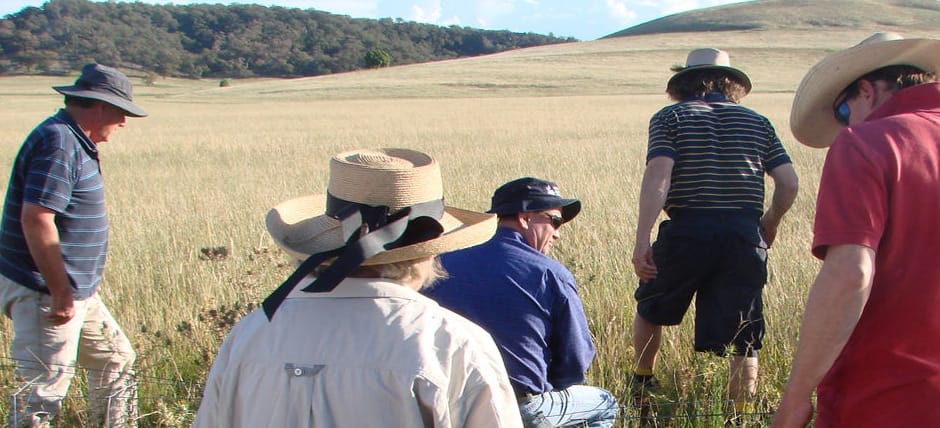
This essay was originally published in Acres magazine. It also appeared onTheSolutionsJournal.com. For more of Courtney White’s writing on conservation and agriculture see: www.awestthatworks.com.>
Author: Courtney White
Since the late 1990s, Australian farmer Colin Seis has been successfully planting a cereal crop into perennial pasture on his sheep farm during the dormant period using no-till drilling, a method that uses a drill to sow seeds instead of the traditional plow. He calls it pasture cropping and he gains two crops this way from one parcel of land—a cereal crop for food or forage and wool or lamb meat from his pastures—which means its potential for feeding the world in a sustainable manner is significant.
As Seis tells the story, the idea for pasture cropping came to him and a friend from the bottom of a beer bottle. Ten of them, in fact.
It was 1993. Seis, a sheep farmer in western New South Wales, and his friend Daryl Cluff, also a farmer, were drinking beer one night, contemplating paradigms. Why, they asked, were crops and pastures farmed separately? Their answer: tradition. They had been taught that pasture and crop systems operated by different ecological processes and were thus incompatible. Crops needed tilling and pastures needed animals. The systems could be alternated over the years, but never integrated. Right? Or wrong? They decided to have more beer.
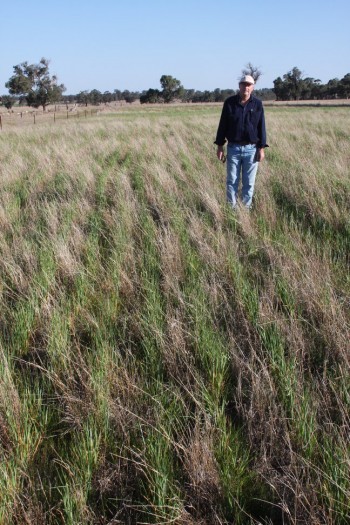
Seis raised the question because he had been watching the native grasses on his farm and began to wonder if nature didn’t intend for annuals and perennials to coexist. Nature certainly wantedweeds in his pasture—so why not a different type of annual instead, such as oats? He knew why: weeds liked to run a 100-yard dash while perennial grasses like to a run a marathon. Two different races, two different types of athletes. Right? Or wrong? They needed another round of beer.
What if it were just one race? What if grasses acted as a kind of cover crop for the annuals, keeping down the weeds but allowing the middle-distance runners, such as oats or barley or canola, to grow while the perennials waited for their turn on the racetrack? More to the point: what if you no-till drilled the perennial pasture during its dormant period with a cereal crop? What would happen?
That was crazy talk, had to be.
The more they drank that night, however, the more the idea intrigued them. Why couldn’t a cereal plant be cropped in a perennial pasture? As farmers, couldn’t they figure out a way to make them all get along symbiotically? If nature could do it, why couldn’t they? That’s when the light went on, Seis said.
“You had to be drunk to think of something like pasture cropping,” Seis told me. “But once we sobered up the next day, we decided to give it a go.”
And give it a go they did.
So have many others. Today, over 2,000 farms practice pasture cropping across Australia, and many more overseas. The idea continues to spread as well. Here are some reasons why:
• high crop yields
• sustained high pasture and animal production from cropped land
• increased fodder for livestock
• high rates of carbon bio-sequestration
• marked improvement in the water-holding capacity of the soils
• improved nutrient cycling
• improvements in biodiversity and resilience, even under drought stress
• significantly reduced input costs and risks
• improved economic return from the vertical stacking of enterprises
• improved happiness quotient on the farm
It is this last point that is perhaps most important, Seis says. As a practice, pasture cropping is pretty straightforward: by growing an annual plant in the competitive niches in the root ecology of a perennial pasture, it avoids the need to kill pasture grasses prior to sowing a crop, thereby maintaining a living plant cover, which improves biological health of the soil and protects from wind and rain erosion.
Plus, a farmer gets two products—crops and animals—from one piece of land. Three, actually, if you harvest the grass seeds as a potential food source, as Seis has done, mimicking the Aboriginals who lived in the area historically.
But it is the social and emotional value of farming regeneratively, as Seis calls it, that matters most to him. To tell the story properly, we need to back up in time.
A New Farm
When Seis gives a lecture or conducts a workshop, he invariably starts with the story of what went wrong with Australian agriculture. It’s his way of putting pasture cropping in context, as well as explaining why he calls itregenerative agriculture—because so much of what happened on the continent’s farms and pasturelands historically was unregenerative. (By the way, they don’t call anything a ranch Down Under. Everything is a farm, unless it’s a huge spread Outback, which is then called astation.)
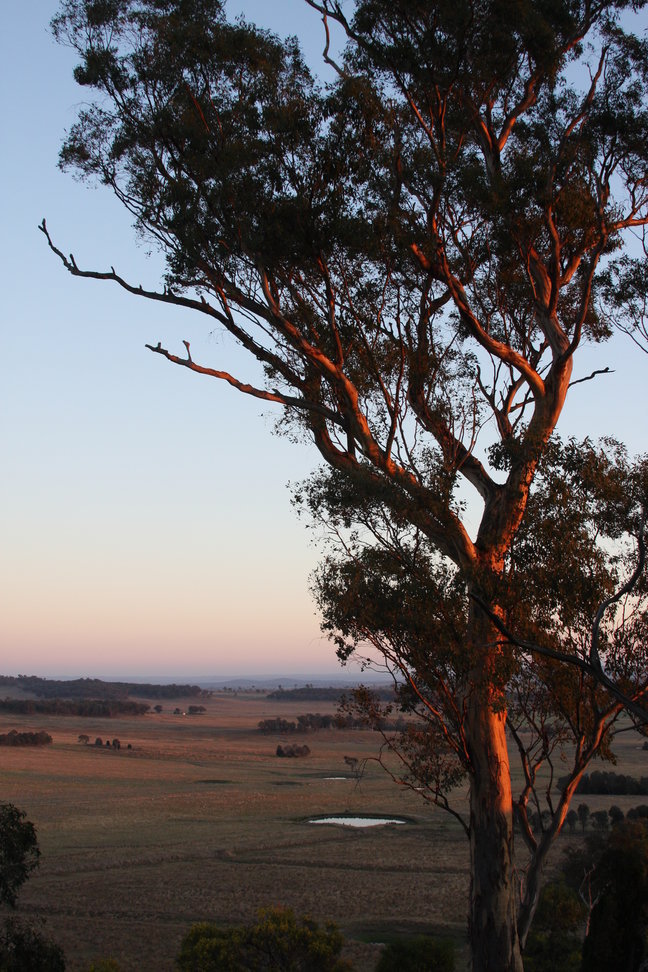
The destruction of Australia’s grasslands began 150 years ago, says Seis, with inappropriate grazing management and, later, plowing, mostly to grow wheat for the nation’s burgeoning population.
Overgrazing, tilling, and the introduction of exotic animals in colonial times, including foxes, rabbits, toads, and a variety of aggressive plant species, all combined to devastate the continent’s naturally nutrient-poor soils and largely defenseless indigenous wildlife. Topsoil began to wash away, along with its precious carbon and other organic matter, causing a general decline in overall soil health and crop productivity. Everything sped up with the introduction of the mechanized tractor in the 1920s, and not in a good way. This was followed by widespread application of herbicides, pesticides, and chemical fertilizer in a desperate attempt to salvage what remained of the soil’s fertility.
Seis knows this story first hand—he saw it happen on his family’s 2,000-acre farm, called Winona, located 180 miles northwest of Sydney.
Seis’ grandfather resisted the industrial changes being pushed on Australian wheat farmers by agricultural companies and government agencies. He was doing fine, Seis said. His son, Harry, however, decided to try something called New Manure, which turned out to be an early version of superphosphate, in an attempt to boost declining yields. His father objected, asking, “What’s wrong with the old manure?” Trouble slowly escalated after Seis’ father bought a tractor. He didn’t know it, but his increased plowing was depleting the soil, reducing carbon especially. A vicious cycle ensued: less fertility in the soil meant more chemical inputs were needed to compensate, round and round. Then the farm began to fail. Costs kept rising, fertility kept falling, salinity rose, trees began to die—and they were going broke.
“Still, the ‘moron principle’ prevailed in my family,” said Seis, his voice rising slightly, “you know, more fertilizer on and more on.”
The farm ended up becoming dysfunctional and unprofitable. The granite soil on Winona had become compacted and acidic, and organic carbon levels had dropped to below 1.5 percent. The topsoil had declined to less that 100 millimeters deep and the subsoil had become sodic. Areas of salinity were also breaking out around the property as well.
Then, in 1979, a wildfire burned almost all of Winona. Three thousand sheep died, all of the buildings were destroyed, 20 miles of fencing burned up, trees exploded, grass died, and Seis ended up in the hospital with burns on his body.
“Worst of all, there was no money to recover things with, which means we had hit rock bottom,” Seis explained. “My grandfather had the last laugh, I’m afraid.”
When Seis had recovered from his burns, he decided to rethink the way he had been practicing agriculture. It wasn’t a criticism of Seis’ father, who had followed the rules of farming for the time, but rather a realization that the rules themselves needed to change. The fire suddenly created an opportunity to do just that. Out of the ashes, Seis vowed, a new farm would emerge.
The first step was to physically rebuild the farm, which took two years and lots of help from neighbors. The second step was to go cold turkey on fertilizer, herbicides, and pesticides, because they couldn’t afford them. The pastures collapsed as a consequence. “They were addicted to phosphorus,” Seis said. The third step was to research native grasses. Could they come back? Would they be an acceptable alternative? His father had battled against native grasses all his life, Seis told me, and they kept returning despite his efforts at eradication. This raised a question in Seis’ mind: if they keep wanting to come back, why not let them? Apparently, they want to be on the farm.
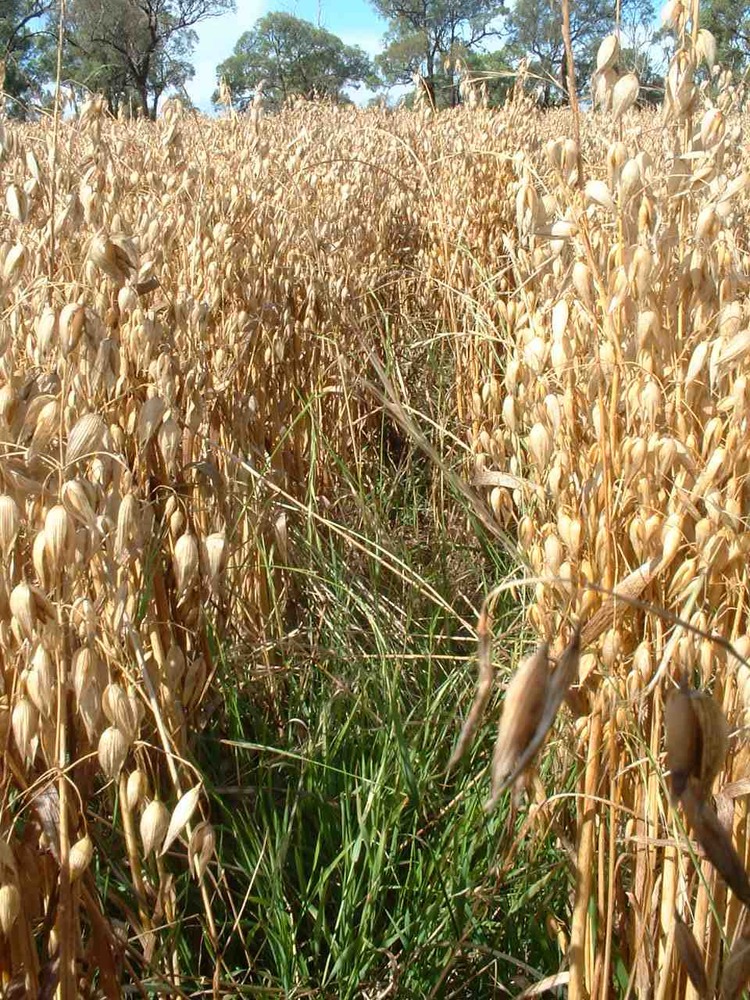
This led to the fourth step: study the holistic management ideas of Allan Savory, who had developed a way of managing animals on pasture that mimics the graze-and-go behavior of wild herbivores. Seis resisted initially, but again felt that he had no choice. He quickly learned that it worked, especially when he sicced his sheep on the non-natives (with his father’s reluctant blessing). This new approach created a long transitional period of low productivity, which reinforced his neighbors’ belief that native grasses were not as productive as introduced ones. But Seis persisted with his plan.
“I’m stubborn like my dad and his dad,” Seis said. “I wasn’t sure if that was a good thing or not for a while, but in the end it paid off.”
By 1990 things had improved substantially, and Seis was seeing benefits both on the land and in his bank account. But Seis knew it wasn’t enough to completely repair all the damage that Winona has endured over the years. He needed a new idea.
That’s where the beer came in.
“Before industrialized agriculture was developed, the world’s grasslands and farms contained hundreds of plant species of all sorts,” Seis said. “And they functioned with very few problems like disease, insect attack, or weeds because it was a balanced ecosystem. Pasture cropping returns that balance. It also creates good, rich soil with high carbon levels and good water-holding capacity.”
Today, thanks to holistic management, pasture cropping, and other regenerative practices, Seis can catalog Winona’s recovery in detail:
• conversion to native grassland with over 50 species of grass, forbs, and herbs
• savings around $60,000 annually in decreased inputs
• increased profits from improved sheep-carrying capacity, wool quality, and wool quantity
• crop yields from pasture cropping comparable to yields from conventional cropping with 20-year oat yields averaging 2.5 tons per hectare
• no insect attacks or fungal diseases in crops or pasture
• increases in bird and native animal numbers and species diversity
• big improvement in soil health, soil structure, and water-holding capacity
• significantly higher counts of fungi and bacteria in soil, evident in microbial counts
• average of 150 percent increase in all soil nutrients
• 203 percent increase in soil organic carbon
Today, Seis and his son Nicholas run around four thousand Merino sheep on Winona and pasture crop around 200 hectares (500 acres) annually in oats, wheat, and cereal rye.
Winona has left rock bottom far behind. So have Seis and his family.
How It Works
The key to how pasture cropping works is the relationship between cool season (C3) plants and warm season (C4) plants—the difference being the number of carbon molecules and how they affect the process by which glucose is produced in a plant. C3 plants, such as wheat, rice, oats, and barley, grow early in the season and then become less active or go dormant as temperatures rise and light intensity increases. In contrast, C4 plants, such as corn, sorghum, sugarcane, and millet, remain dormant until temperatures become warm enough to switch on and begin growing.
Pasture cropping utilizes the niche created by C3 and C4 plants. When a C4 is dormant (during winter), a C3 plant seed is sown by no-till drilling into the C4 pasture. With the onset of spring, the C3 plants begin to grow. If managed properly, plus the right amount of rain, the C3 crop can be harvested before the C4 plants begin the vigorous part of their growth cycle. The removal of the C3 crop will then stimulate C4 plant growth (due to reduced competition). The mix of shallow- and deep-rooted plants also access water resources in the soil differently, which can reduce competition and increase overall productivity.
Central to understanding the process is understanding what’s happening in the soil. C3 cereal crops provide sugars to soil microbes, such as fungi, nematodes, and protozoa, during the time when the C4 plants are dormant, which can improve soil fertility faster than a C4 pasture alone might. This also speeds up nutrient cycling, promotes an improved water cycle, increases nitrogen content, and adds organic matter to the soil, which can build humus. Additionally, the no-till drill lightly aerates the soil, allowing oxygen and water to infiltrate.
Another key is using grazing animals to prepare the C4 field before drilling. Grazing animals hit the perennial pasture hard, which gives the C4 plants a “headache,” according to Seis, so that the C4 plants come up slowly, giving the C3 plants a chance to grow. By hitting the pasture hard with a large mob of sheep in a time-controlled manner, Seis can keep the C4 plants from growing too tall too early, and thus prevent them from shading the C3 plants. Animals can also control weeds, create litter on the soil surface, supply a pulse of organic nutrients for the crops, and remove dry plant residue from the pasture.
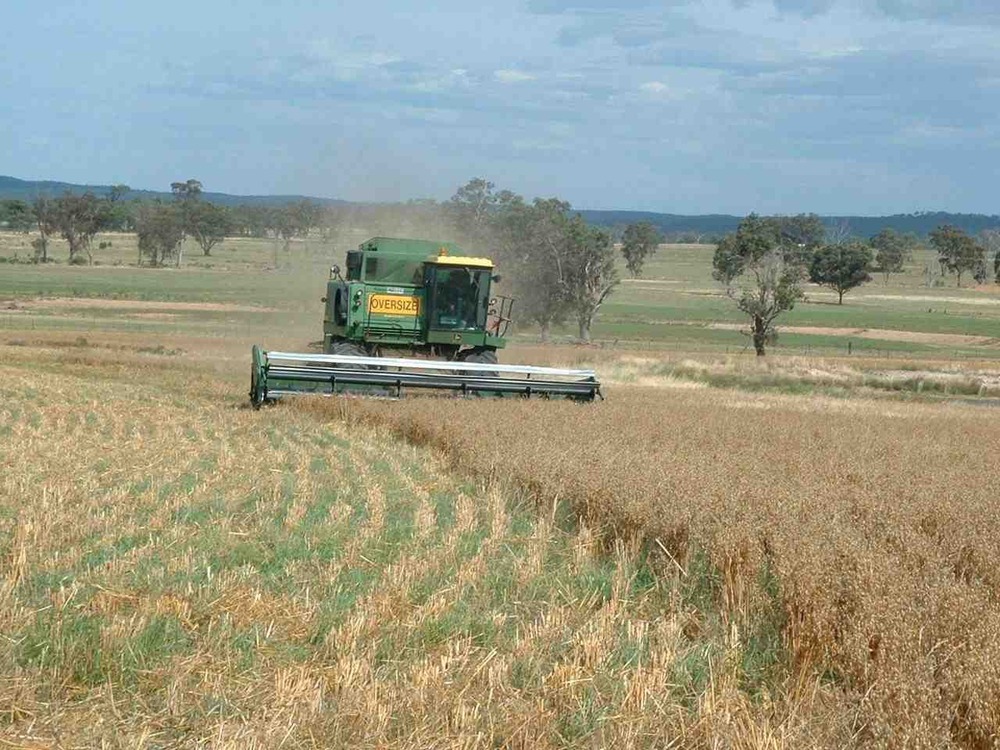
Seis says his use of sheep mobs has been controversial in some quarters due to a concern about soil compaction. This is only a problem where there are low levels of ground cover and litter, he says, or when the ground is very wet. “Where there are good perennial pastures and ground cover,” says Seis, “pasture-cropped paddocks show very little compaction and soil structure problems.”
After the oat crop is harvested, the grazing begins. This process, which largely avoids chemical fertilizer, herbicides, and pesticides, has brought tremendous benefits to the soil.
Proper sowing is another key. So is an assessment of a pasture’s potential before a farmer tries to crop it. Seis has some advice before sowing: Graze the paddock to three to four inches. Create as much litter as possible. Use an herbicide to control weeds only if absolutely necessary. Use no-till equipment to sow at the correct depth and row spacing. Sow the correct crop for your soil type. Conduct a soil test, if possible. Sow crops up to two weeks earlier than usual (crops sown by pasture cropping are slower to develop). Avoid the use of fertilizer as much as possible—it shouldn’t be necessary. In Seis’ case, he started with normal rates of fertilizer, but reduced its use by 70 percent over time and today only uses organic fertilizer at very low rates.
One more key: never, never, never use a plow.
Seis also cautions that crop yields at the beginning are usually lower than with conventional industrial agricultural methods. He says this is more than offset by the ability to produce two (or three) products from the same bit of land, plus all the fertility that is being built up in the soil.
In 2010 the University of Sydney conducted a research project on Winona and an adjoining farm to evaluate the effects of pasture cropping versus conventional management on soil health and ecosystem function. Under the direction of Peter Ampt, the project compared paddocks of similar size on each farm. Here are some of the results of the research: Winona’s paddock was 83 percent native perennial grass species, while the neighbor’s paddock was 88 percent annual weed species. There was greater ecosystem function on Winona. Soil microbial counts showed that Winona had significantly higher amounts of fungi and bacteria over the neighboring farm. Finally, crop yields were the same on the two farms, and Winona’s sheep-stocking rate was double.
In the study’s conclusion, Ampt and Sarah Doornbos write:
These results illustrate that the rotational grazing and pasture cropping practiced on the innovator site can increase perennial vegetative ground cover and litter inputs, compared to the continuous grazing system and conventional cropping practiced on the comparison site. Increased perenniality and ground cover lead to improved landscape function in the pasture through increased stability, water infiltration and nutrient cycling, which in turn can lead to improved soil physical and chemical properties, more growth of plants and micro-organisms, and an ultimately more sustainable landscape. It also shows that rotational grazing and pasture cropping can improve landscape function while sustaining similar or higher stocking rates over the year compared to the conventional system.1
The study corroborated Seis’ intuition about what was happening on Winona. It also proved that he hadn’t been so drunk after all!
More Good News
There are other good reasons to give pasture cropping a go.
It can be used as a land-restoration strategy, for example. That’s precisely how Seis used it on Winona—to convert a worn-out, weed-dominated, burned-over, failing patch of farmland into an ecologically healthy and economically profitable landscape. He did it by rotating pasture cropping around his farm over time, generally only cropping one quarter of his farm at a time. Seis is convinced the same strategy can be used anywhere similar C3-C4 plant relationships exist. “It’s a great way to rebuild grasslands and can happen almost anywhere there’s enough rain to grow a crop,” he says. In arid environments, he says, you must drill more carefully and expect yields to be lower, especially in the first few years. “It can also be done with horses or electric engines, I suppose,” he says. “You’re only limited by your imagination.”
By the way, don’t use fire to do this job, he insists. Don’t burn anything. “Throw your matches away,” he instructs. Use livestock instead.
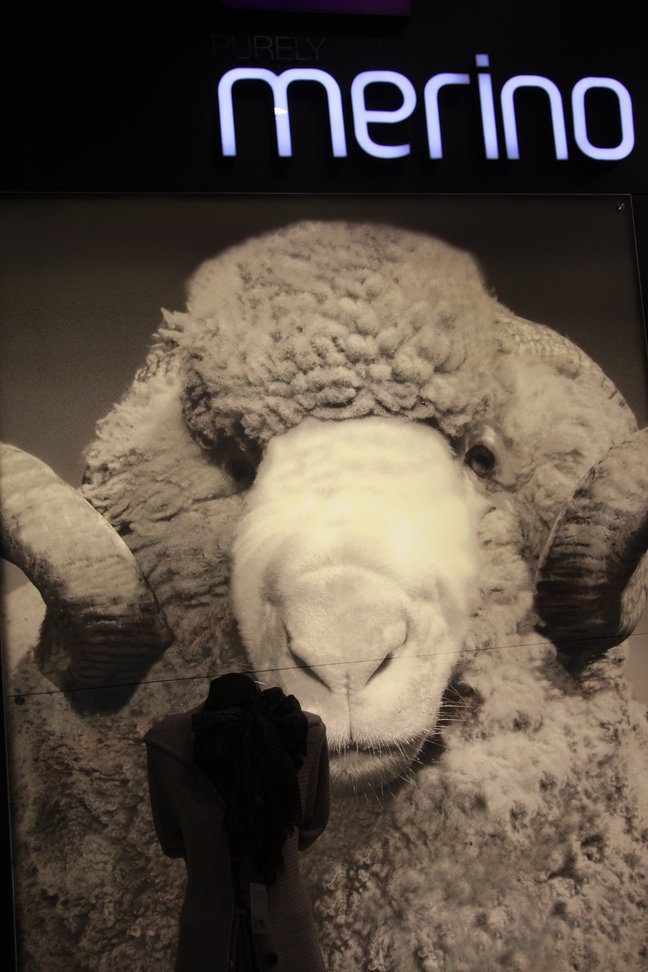
Another benefit is increased carbon, which Seis calls “rocket fuel for plants.” According to research conducted by Christine Jones, soil organic carbon has increased 203 percent over 10 years on Winona compared to the same neighboring farm studied by Ampt (the farm is owned by Seis’ brother, who, Seis says, has been a good sport and good conventional farmer). Jones calculates that 171 tons of CO2 per hectare has been sequestered to a depth of half a meter on Winona. This has contributed to a dramatic increase in the water-holding capacity of the soil as well, which, according to Jones has increased by 200 percent in 10 years and can now store over 360,000 liters per hectare with every rainfall event.
It’s the same with other minerals. Winona has seen the following increases: 227 percent more calcium, 138 percent more magnesium, 146 percent more potassium, 157 percent more sulphur, 186 percent more zinc, 151 percent more phosphorus, 122 percent more iron, 202 percent more copper, 156 percent more boron, and 179 percent more cobalt. It has 277 percent more calcium than the neighboring farm, and 151 percent more phosphorus.
Another benefit is what some farmers callvertical stacking—the stacking of enterprises on a farm that fit together and thus build more profit per acre. Pasture cropping is a perfect example. It also lowers the cost of growing crops to a fraction of conventional cropping methods. The added benefit is that up to six months extra grazing is achieved compared with the loss of grazing due to ground preparation and weed control required in traditional cropping methods. Other benefits include the recruitment of perennial plant numbers and diversity of the pasture following the crop. This means that there is no need to re-sow pastures, which can cost from $100 to $150 per hectare.
“The best way to improve your profits is to improve your soil,” Seis likes to say.
And there’s no reason pasture cropping can’t be done organically, thus adding value to both the cereal and animal products. Winona isn’t certified organic, mostly because Seis likes to keep “every tool in the toolbox” when managing the land. But it would be very easy for someone else to farm organically.
All of these reasons are why pasture cropping has spread to 2,500 farms across Australia and a few other nations as well, including the United States, Norway, and South Africa, according to Seis. The main obstacle is climate—grass species need a true dormant season for the technique to work properly, a condition that is unusual in tropical and sub-tropical environments. Another obstacle can be the land’s lack of perennial grasses due to overgrazing, drought, or a combination of the two. This can be overcome, however, by re-sowing grass species and then encouraging their growth through pasture cropping, which stimulates plant vigor and seed recruitment once grasses take hold.
There’s one further obstacle, Seis told me: our brains. Age-old practices and beliefs, such as plowing, are too frequently the number one impediment to the adoption of innovative ideas. Moving our brains “out of the way,” as Seis puts it, is necessary. And it isn’t easy, he notes.
For Seis, it took 10 beers!
———————
Again – this essay was originally published in Acres magazine. For more of Courtney White’s writing on conservation and agriculture see:www.awestthatworks.com.
References
1. Ampt, P & Doornbos, S. Communities and Landscapes project: Benchmark Study of Innovators. The University of Sydney (2011) – View HERE
